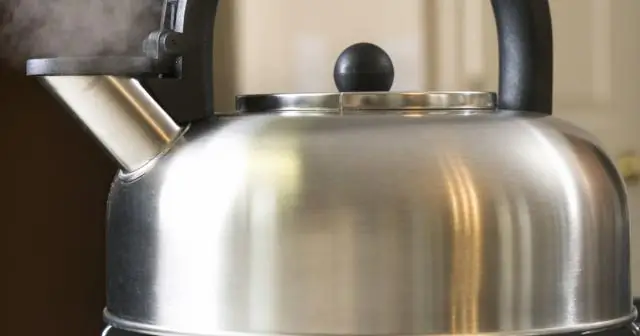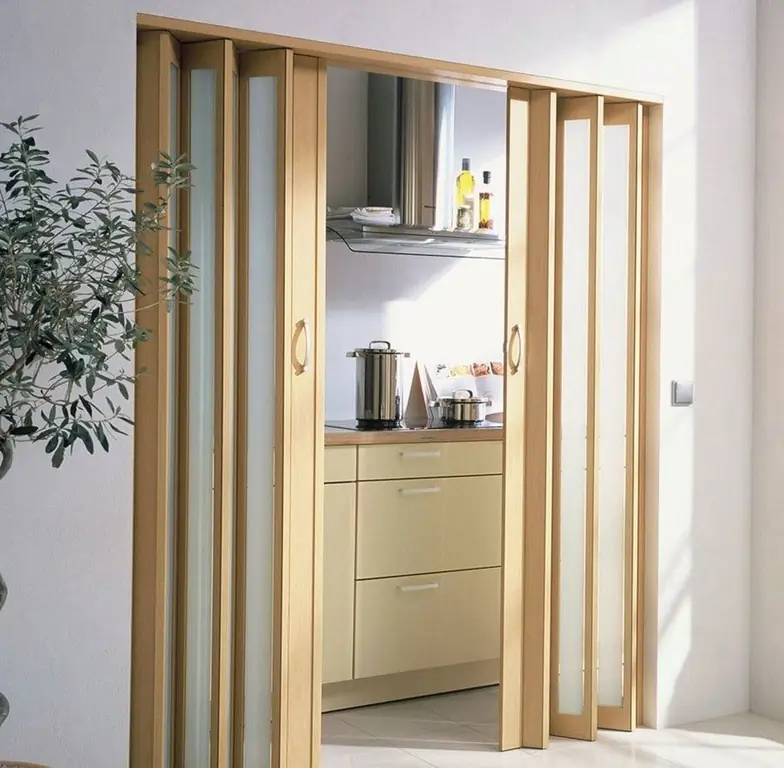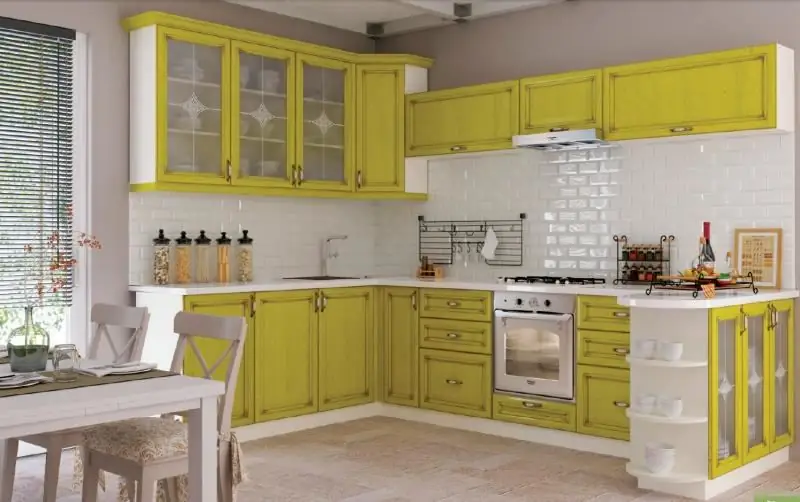
Table of contents:
- Author Bailey Albertson [email protected].
- Public 2023-12-17 12:53.
- Last modified 2025-06-01 07:32.
Choosing stainless steel dishes

Stainless steel dishes look beautiful in the kitchen and are distinguished by their durability, ease of care, and the ability to cook the most healthy meals. But stainless steel is different from stainless steel, so before buying it is important to familiarize yourself with the characteristics of the model of interest. In addition to the appearance, you need to pay attention to the steel from which the dishes are made, what is the thickness of the walls and bottom, are there any convenient "chips" like temperature sensors, a measuring scale, protective pads on the handles.
Content
- 1 What is stainless steel cookware
- 2 How are stainless steel cookware made
-
3 Recommendations for choosing stainless steel cookware
- 3.1 Wall and bottom thickness, capacity
- 3.2 Features of handles and lids
-
4 Popular manufacturers of stainless steel cookware
- 4.1 BergHoff
- 4.2 Rondell
- 4.3 KaiserHoff
- 4.4 "Gourmet"
- 4.5 Tescoma
- 4.6 Zepter
- 5 Care of stainless steel cookware
What is stainless steel cookware
Stainless steel (in the common people "stainless steel") is steel, to which various impurities are added to increase resistance to corrosion in the atmosphere and corrosive environments. The material is food grade and industrial. In the latter case, when heated and interacting with fats, oxidation and the formation of compounds that pose a threat to humans occur. Steel suitable for the production of kitchen utensils does not emit hazardous substances - it includes such stainless steel grades as AISI 201, 202, 304, 316, 430.
AISI 201 and 202 are so-called medical steel, but are sometimes used in the manufacture of kitchenware. Manganese is used as the main impurity, possibly a small content of nickel. Products from this steel grade should not be exposed to long heating, therefore, only bowls, gravy boats, cutlery, and ladles are made from it.

Cutlery and ladles are made of steel grade 202
AISI 304 (08X18H10 or 18/10) is austenitic, that is, high-temperature steel. It is considered one of the most durable and resistant to aggressive environments material for cookware. Easily tolerates heating to high temperatures (for example, withstands a short-term rise in temperature to 900 degrees Celsius). Suitable for storing food.

Pots and pans made of AISI 304 steel best withstand high temperatures
AISI 316 (08Х17Н13М2) - steel, similar in properties to grade 304. The composition contains 2.5% molybdenum, due to which the dishes become resistant to corrosion, high temperatures and aggressive environments. The AISI 316Ti grade contains titanium, which adds strength to the resulting products.

Zepter frying pan made of AISI 316 steel
AISI 430 is a steel that is produced without the addition of nickel. The chromium content is within 17-27%. Crockery from this material is often made, as it is cheaper than from steel 316 and 304. Various kitchen items are made from this stainless steel - and pots, and pans, and cutlery.

The pans of the Brazilian company Tramontina are made of AISI 430 steel
Dishes from any brands of stainless steel combine advantages:
- durability. On average, stainless steel products last 20 years or more. Many firms give a guarantee for this period;
- ease of care. The utensils are easily and quickly washed from food debris by hand or in a dishwasher;
- attractive appearance. The dishes will be appropriate in any interiors (but it looks especially impressive in high-tech, modern, loft-style kitchens).
Heat-resistant products can be used in all ovens except microwave ovens. Suitable for use on gas, electric and induction cookers. They have high non-stick properties, which can reduce the consumption of oils and fats. And also the products are characterized by thermal accumulation, that is, the cooked dishes will keep warm for a long time.

You can turn off the stove early - under the influence of heat inside the pan or saucepan, the dish will reach readiness and at the same time retain the maximum of useful substances
There are also cons for stainless steel dishes. For example, there are easily scratches on it from knives and forks, metal brushes. It should also be borne in mind that the highest quality products (from the best steel grades, multi-layer) are not cheap. But this disadvantage is compensated by the long service life.
How stainless steel cookware is made
Stainless steel products can be solid and stamped. The casting method consists in pouring a hot liquefied alloy into a mold with a complete repetition of the configuration and dimensions of the cavity. The alloy is then cooled and removed from the mold. In the production of stamped utensils, steel sheets are first created and, while they are heated to high temperatures, are passed through presses that shape the workpiece into the desired shape.
Professional chefs mainly use stainless steel cast utensils. Although its cost will be 2-3 times higher than stamped, it is stronger and more durable. The quality (and, accordingly, the cost) of the presence of the encapsulated bottom in pots and pans increases even more. The result is a multi-layer construction.
The inner element of the capsule bottom is made of lightweight metal. Aluminum sheets are used as an interlayer. From above, the base is closed on both sides by stainless steel with high thermal conductivity. The capsule can only consist of stainless steel, but of different brands. For example, 304 AISI steel can be used as the base material, and an additional layer of AISI 430 steel is applied to the bottom. Such layering improves the properties of the utensils, making them more durable and resistant to temperature effects.

The thermal conductivity of pans with a capsule bottom is increased, therefore cooking time is reduced
Recommendations for choosing stainless steel cookware
When choosing stainless steel dishes, you need to pay attention to its characteristics.
Wall and bottom thickness, capacity
The thickness of the walls and bottom is an important parameter for kitchen utensils. Too thin products will not last even a year, excessively thick ones will be heavy and difficult to heat up to the desired temperature. According to GOST 27002-86, the walls of stainless steel cookware should be:
- pots, saucepans - 0.5-1 mm;
- pans - 0.8-1.2 mm;
- kettles - 0.5-1 mm;
- plates for cold dishes, sauce bowls - 0.4-0.8 mm;
- colanders - 0.5-0.8 mm;
- buckets - 0.5-1 mm.

A Chinese-made pan has a wall thickness of only 0.3 mm, which does not meet the requirements of GOST - such a model is inexpensive and light in weight, but it will be inconvenient to cook in it
As for the bottom, a thickness of 3 mm or more is recommended for utensils. A thinner bottom will quickly warm up, and the steel will "fail" in just a couple of months (from high temperatures it will be covered with waves, bumps).

According to modern Tri-ply technology, the entire body is encapsulated - the thickness of the walls and bottom remains the same, but the strength and resistance to aggressive environments significantly increase while reducing the total weight of the utensils
The volume of dishes varies. For example, stainless steel pots can hold from 1 to 15 liters. Frying pans - from 0.4 to 6 liters.

Judging by the statistics of Yandex. Market, pots with a volume of 2.8, 3.5, 5 and 6 liters are most actively sold for home use.
Features of handles and lids
The ease of use of the utensils depends on the material and shape of the handles. These elements should not deform under a load equal to three times the mass of water contained in the product. Often in steel pans, the handles are made of cast steel or aluminum. They turn out to be durable, but quickly heating up and cooling down for a long time - you cannot do without a towel and a grip.

Cast steel handles are durable but take a long time to cool
Convenient are pots and pans with wooden, plastic and rubberized covers on the handles - they do not heat up and the dishes can be taken from the stove without towels. The downside of wood and plastic is that they quickly lose their attractive appearance, easily crack, fade. The rubber pad on the handles is more durable and pleasant to the touch, but sometimes it may smell a little when heated (low-quality elements also leave marks on the hands).

The pan with rubberized handles is convenient to use - you can take it without a grasp or a towel
Metal lids for pots and pans are durable and reliable. Most often they are made from the same material as the utensil itself. The main disadvantage of this option is opacity: you can assess the state of the dish only by sliding the lid. Glass products are more convenient in this regard. They are easier to care for (traces of grease and food debris are easier to wash off), but more fragile (if dropped on the floor, the glass can crack, crack, while nothing bad will happen with a steel lid).

There are combination lids - made of stainless steel and glass
Popular manufacturers of stainless steel cookware
On sale you can find many options for pots, pans, saucepans, stainless steel cutlery. The most popular are the dishes from the following factories:
- BergHoff (Belgium);
- Rondell (Germany);
- KaiserHoff (China);
- Gourmet (Russia);
- Supra (Russia);
- Tescoma (Czech Republic);
- Zepter (Switzerland).

Stainless utensils can be bought individually or in ready-made sets of pots, saucepans and pans of different sizes
BergHoff
The thickness of the pots' walls meets the requirements of GOST (0.5-0.7 mm), but the bottom is quite thin (from 2.3 to 2.8 mm, depending on the model). The lack of thickness is compensated by an unusual insert that is typical for all BergHoff utensils - a copper penny, soldered on the outside of the bottom.

A set of 6 items costs from 33,500 rubles, all dishes are made of steel 18/10
Approximate cost of BergHoff cookware:
- a frying pan with a diameter of 20 cm, a volume of 2.4 liters - 4600 rubles;
- a frying pan with a diameter of 24 cm, a volume of 2.7 liters - 7200 rubles;
- stewpan with a volume of 2.5 liters - 6100 rubles;
- a saucepan with a volume of 2.3 liters - 5700 rubles;
- a saucepan with a volume of 4.9 liters - 8100 rubles.

Casserole BergHOFF Tulip with a volume of 1.8 liters is equipped with a glass lid with a steel frame

BergHoff cookware has won many design and quality awards - including the Henry van de Velde Awards, Good Design, iF Product Design Award
Rondell
The factory produces high quality stainless steel cookware, including premium ones. The manufacturer provides a 25-year warranty for all products.

Rondell pots have rubberized covers on the lid and handles - they can be red, brown, yellow, burgundy, green, black, gray, blue
The approximate cost of Rondell utensils:
- a bucket with a volume of 1.3 liters - 2660 rubles;
- a saucepan with a volume of 2.3 liters - 2890 rubles;
- a saucepan with a volume of 5.7 liters - 4190 rubles;
- a frying pan with a diameter of 24 cm, a volume of 2.7 liters - 3800 r.

In the production of models of the Vintage collection, a unique method of covering the liquid glass outer decal (pattern in the form of craquelure) was used

The Rondell Flamme set contains two saucepans and one saucepan
KaiserHoff
Although the company is considered to be Chinese, the best German specialists are involved in the development of tableware. The production uses steel grade 18/10. Many pans have a convenient measuring scale on the side. All tableware of this factory belongs to the economy class.

KaiserHoff cookware belongs to economy class
Approximate cost of KaiserHoff utensils:
- a set of 4 pots, 1 saucepan, 1 frying pan and 5 lids - 3500 rubles;
- a set of 5 pots, 1 frying pan and 6 lids - 2090 R.;
- a saucepan with a volume of 2.3 liters - 700 rubles;
- saucepan with a volume of 7 liters - 1300 r.

Select KaiserHoff models come with colorful plastic handle trims

The line of stainless steel cookware from Kaiserhoff includes not only pots and pans, but also kettles
Gourmet
The Ural company "Gurman" has existed since 1992. Offers a large selection of stainless steel dishes: from pots and pans to measuring containers, cutlery, lids.

The firm "Gurman" produces stainless steel pots with a three-layer bottom
The approximate cost of Gourmet cookware:
- saucepan "Classic" with a volume of 3.5 liters - 2790 rubles;
- saucepan "Profi" with a volume of 5 liters - 3200 rubles;
- a frying pan with a diameter of 24 cm, a volume of 2.5 liters - 2300 rubles;
- saucepan "Classic" with a volume of 1.5 liters - 2180 rubles.

The collection of the "Gourmet" company has special pots - for example, to cook dumplings and manti

Buying sets of dishes is more profitable than buying each item separately
Tescoma
In Europe, the utensils of this brand are very popular and have won various prizes more than once (for example, in 2006 and 2017, Tescoma pots were included in the top ten most bought items for the kitchen). The cost of the dishes is considerable, but they are very durable and convenient to use. The series of elite products includes pots and pans with a wall thickness of 0.7-1 mm and a thick three-layer bottom with a 5 mm aluminum disc. In the economy segment, the dishes are thinner (0.6 mm) and the bottom is 3 mm thick.

10-piece set of stainless steel - 5 pots and 5 lids
The approximate cost of Tescoma cookware:
- frying pan Wok PRESIDENT with a diameter of 32 cm - 15700 rubles;
- Frying pan GrandCHEF with a diameter of 28 cm with a long handle - 3350 rubles;
- casserole GrandCHEF with a volume of 3.5 l - 4320 rubles;
- pan SmartCOVER with a volume of 2 l - 4300 r.

The wok comes with a tempura grid and a steaming grid

The TESCOMA collection features children's knives, forks and spoons made of stainless steel and decorated with fun designs on the handles
Zepter
The company uses its own patented type of alloy (a small amount of silver or platinum is added to 18/10 steel). All utensils have a thick bottom up to 1 cm, and the walls are at least 1 mm.

Many models of Zepter pots and pans come with lids with built-in thermo indicators
The approximate cost of Zepter cookware:
- a saucepan with a volume of 3 liters - 18,900 rubles;
- a pan with a volume of 4.2 liters - 20130 rubles;
- Zepter Masterpiece CookArt frying pan with a diameter of 24 cm - RUB 24,900;
- saucepan Zepter Masterpiece CookArt with a lid - 24500 rub.

The Zepter Masterpiece CookArt frying pans, saucepans and pots are made specifically for induction hobs, but they can also be used on gas and electric hobs.

Meals cooked in Zepter steel cookware are not only tasty and appetizing, but also healthy
Stainless steel cookware care
Despite the increased strength, stainless steel cookware requires special handling. Of course, even with inaccurate use, the probability of its complete failure is minimal (you have to try very hard to appear cracks, chips, breaks). But with improper care, the utensils will lose their attractive appearance.
Do not use hard scouring pads or abrasives to clean steel dishes. And you also have to give up detergents with chlorine or ammonia in the composition. Be sure to wipe the walls of pots, pans, cutlery dry - this way they retain their mirror shine longer.

Stainless steel dishes can be washed by hand and in the dishwasher
Stainless steel utensils are much stronger than enameled ones, they do not crack due to sudden changes in temperature or accidental impact. Such dishes heats up quickly and retains heat for a long time, and the dishes in them do not burn. But these characteristics apply only to high-quality steel products manufactured in compliance with all standards.
Recommended:
How To Clean A Burnt Stainless Steel Pan, How To Clean Inside And Outside At Home

Information on how to clean a stainless steel pot using available tools. Traditional methods of getting rid of soot, fat, burnt food, water stains
Doors For The Kitchen And Their Varieties With A Description And Characteristics, As Well As Features Of The Device And Operation

What are the types of doors to the kitchen and how to determine the dimensions of the structure. Rules for self-installation and maintenance of kitchen doors
Kitchen With Patina On The Kitchen Set And Furniture: What It Is, Interior Design Features, Photo

What is patina. Advantages and disadvantages of patination. Kitchen design with patina: colors, styles and interior features
Chimneys Made Of Stainless Steel, Including How To Choose, As Well As Features Of Installation And Operation

What are stainless steel chimneys, how to choose them correctly. Installation of internal and wall chimneys. Features of operation and owner reviews
How To Clean The Pan From Burnt Jam Or Sugar (enamel, Stainless Steel, Etc.)

How to clear burnt sugar or jam from a saucepan. Effective cleaning methods for aluminum, enamelled and stainless steel pots and pans
